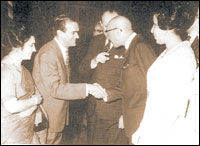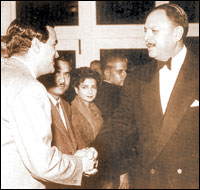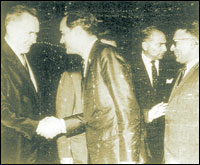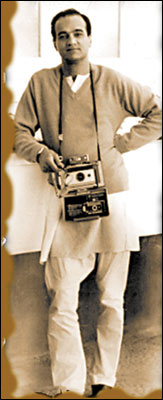Sowing
and reaping, is a long and continuous process. Usually the work done
by one generation benefits the future generations, but Mir Khalil-ur-Rahman,
the founding father of Jang Group of Newspapers, had the distinguished
honour of achieving his great mission during his life time. generations, but Mir Khalil-ur-Rahman,
the founding father of Jang Group of Newspapers, had the distinguished
honour of achieving his great mission during his life time.
On the occasion of the 16th death anniversary of Mir Khalil-ur-Rahman,
it is a privilege for this scribe to pay tributes to the memorable
personality whose immense contribution resulted in building an institution
in the Islamic Republic of Pakistan as opposed to the civilian despots
and military rulers who destroyed such institutions.
Mir Khalil-ur-Rahman, launched his mission during the Second World
War (1939-1945), in the early 1940s by starting the publication of
'Daily Jang' from Delhi. The newspaper received the distinction of
playing a glorious role in the independence movement, particularly
for the creation of Pakistan.
Even in the undivided India Mir saheb succeeded in attracting gems
like Yusuf Siddiqui, Syed Mohammad Taqi and Raees Amrohvi to his newspaper.
Mir saheb started his maiden venture with a scrap, but through sheer
hard work and with the cooperation and support of his faithful colleagues,
succeeded in making 'Jang' the number one Urdu newspaper in the world
(as he used to proudly note).
Mir saheb was amongst the senior reporters of the Daily Jang and Daily
News (the premier English eveninger), he was also one of the founder
columnists of the popular Urdu weekly, 'Akhbar-e-Jahan' and English
Weekly the 'Mag'. Working with Mir saheb I got many opportunities
to learn from his experiences and guidance. He encouraged and appreciated
the hard work of his employees.
Learning is a process, which starts from the cradle and continues
till the grave. This was the first lesson, which I learned during
my association of about a quarter of a century, with Mir saheb and
the Jang group.
For 16 to 18 hours daily he used to indulge in multifarious pursuits,
he also kept himself abreast of the latest developments in printing
technology. He imported the most modern printing machines, cameras
and scanners from Germany, the United States, Great Britain and Japan
so as to improve the quality of journalism in Pakistan.
Noori Nastaliq, the Urdu computer composing was initially introduced
by 'Jang' and later on the other Urdu newspapers also adopted this
process.
Mir Khalil-ur-Rahman had the ability to judge predict, and to see
things in their proper perspective. He was a meticulous planner and
gave personal attention to the coverage of all local, national and
international events, functions, and important occasions.
An year after the imposition of the first Martial Law on 7th October,
1958 by General Mohammad Ayub Khan, the federal capital was transferred
from Karachi to Rawalpindi.
During this period, under Mir Khalil-ur-Rahman's stewardship, the
Jang group started publication of the newspaper in the new interim
capital as well and religiously and practically pushed an independent
policy. He believed in providing equal coverage to all the sections
of the society, including the smallest political organisations, groups,
factions, and his paper remained unbiased towards all the political,
religious and ethnic groups.
In October 1962, Mir saheb started the publication of Daily News from
Karachi and in 1966 the Jang group launched Urdu weekly 'Akhbar-e-jehan'
in technicolour.
The publication of the daily Urdu 'Jang', six issues a week, started
from London in the early 1970s. Hence Jang became the first Urdu newspaper
to be simultaneously published in Asia and Europe. Later on, 'Jang'
also made its appearance from Quetta and Lahore in the 1980s.
In February 1991, the English daily 'The News' was launched simultaneously
from Karachi, Lahore and Rawalpindi and later on from London. It was
a historical achievement by Mir saheb, as the projects started by
Jang group emerged as leaders in their respective fields. This extra-ordinary
success was the result of the combination of various factors, including
his selection of creative teams. Mir saheb was lucky enough to attract
almost all the top columnists of the country including Majeed Lahori,
Ibrahim Jalees, Shaukat Thanvi, Niaz Fatehpuri, Ahmed Nadeem Qasmi,
Pri Ali Mohammad Rashdi, Nasrullah Khan and Inam Wali Durrani to his
organisation.
Some of the best news gatherers and presenters including Yusuf Siddiqui,
Inam Aziz, Ather Ali, Irshad Ahmed Baig Chughtai, Afzal Siddiqui,
Ajmal Dehalvi, Mahood Ahmad Madni, Zafar Rizvi, Yunus Riaz, Timsal,
Askari, Akhtar Alam and Hafiz Mohammad Islam and the serving editor
Mehmood Sham left no stone unturned to make 'Daily 'Jang' an outstanding
newspaper of Pakistan.
Veteran writer, journalist, author and poet Shafi Aqeel also served
the Jang group for about four and a half decades.
The decisive edge, which the publications of the Jang group enjoy
over their competitors, is due to the untiring efforts of their creative
staff and production team. The combined and collective efforts of
these workers under the able leadership of Mir Khalil-ur-Rahman were
instrumental in continuously increasing the circulation as well as
the readership of various organs of the Jang group.
Mir saheb appreciated the dedication and positive contribution of
his workers. The celebrated columnists were among the most pampered
members of the organisation and he gladly tolerated the liberties
taken by some of them. He did not believe in creating bureaucratic
hurdles, instead he believed that a talented worker is an asset to
the organisation. He was easily accessible by all and any member of
the staff could approach him any time.
Arguably the top newspaper magnate of the country Mir Khalil-ur-Rehman
was never negligent of the welfare of the workers. While other press
barons opposed and resisted them, the formation of trade unions was
supported and welcomed by Mir saheb. It was due to this reason that
during his life time the Jang group was always first to implement
Wage Awards for the journalists and other newspaper workers.
He believed in the famous saying that "Eternal vigilance is the
price of liberty", therefore he did not sleep till the last copy
was sent to the press in the early hours of the morning and in the
absence of the staff he himself would rush to the airport for receiving
the delivery of photographs of latest events sent through PIA parcels
from upcountry at midnight in order to include them in the morning
issues. During his career which, spanned over a period of more than
half a century, Mir saheb did not nurture any political ambition.
However, for a brief stint in the mid 1950s, he was elected as a councilor
of the Karachi Municipal Corporation (KMC) from Artillery Maidan,
Karachi. |

